Introduction
I’m very fortunate to live across town from my good radio hobby pal Gary DeBock. He has been responsible for the rapid growth in Ultralight radio DXing and the construction of Ferrite Sleeve Loop (FSL) antennas. Living near each other as we do, I’ve benefited a lot from his expertise and creativity in the hobby. We’ve enjoyed visiting about Ultralight radios and antennas many times over a leisurely lunch. If you’re unfamiliar with Gary’s efforts, just do a YouTube search on his name and see just a few of the many FSL antenna variations he’s built!
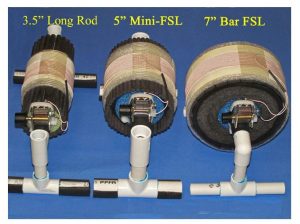 Gary uses PVC tubing, “Fun Noodle” foam cylinders, sections of curved foam, and rubber plumbing adapters almost exclusively as the core supporting structures for his FSLs, from small 3-inch models to 17-inch monsters. Gary certainly has perfected his own techniques with these raw materials; he’s an expert in combining them. He even makes PVC table structures to support his FSLs during Oregon coastal DXpeditions, as seen in some of his YouTube videos.
Gary uses PVC tubing, “Fun Noodle” foam cylinders, sections of curved foam, and rubber plumbing adapters almost exclusively as the core supporting structures for his FSLs, from small 3-inch models to 17-inch monsters. Gary certainly has perfected his own techniques with these raw materials; he’s an expert in combining them. He even makes PVC table structures to support his FSLs during Oregon coastal DXpeditions, as seen in some of his YouTube videos.
These materials work well, but over time even FSLs as small as 7 to 8 inches in diameter begin to sag and lose their perfectly circular shape. This seems to be caused by the shifting of individual segments of foam which are wrapped around a “Fun Noodle” core and center PVC tubing.
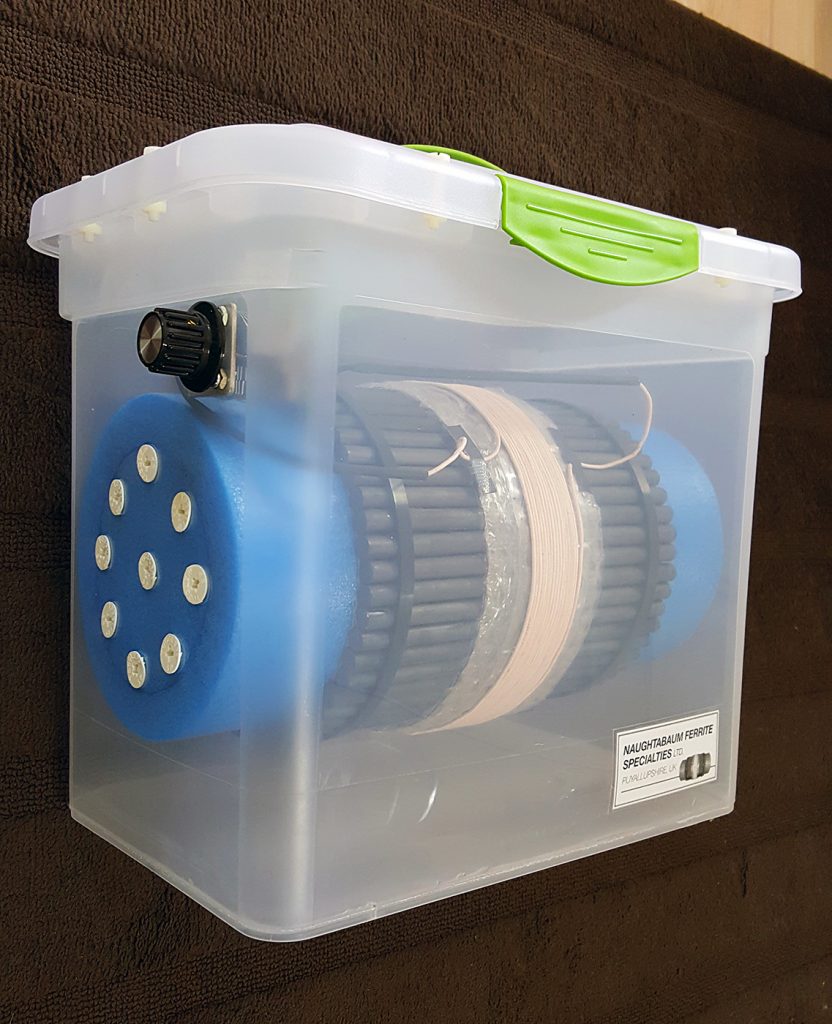 What possibilities are there for other materials in FSL antenna construction? It would be a fun challenge to build a small to medium sized FSL antenna that would have these qualities:
What possibilities are there for other materials in FSL antenna construction? It would be a fun challenge to build a small to medium sized FSL antenna that would have these qualities:
- Maintain a circular cross-section without sagging
- An appearance less like a threatening explosive and more like a commercial product
- Use alternate construction methods for those not skilled with cutting & gluing PVC tubing
I began to keep my eyes open for likely candidates as I visited hardware stores, department stores, and office supply outlets. Eventually some ideas began to gel.
Raw Materials
Here is a visual and descriptive list of what I used in this alternate design of Ferrite Sleeve Loop antenna. I won’t go into great detail about dimensions, quantities, and measurements, as other DIYers should be able to easily follow the general idea presented here. This article is mainly to get you thinking about other ways to construct a ferrite sleeve loop antenna.
The Core of the Matter
T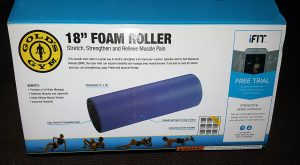 his 18-inch long, semi-rigid foam roller is six inches in diameter. It’s a workout and exercise aid which I found in the sports department of my local Walmart store. The cost was approximately $13. This one-piece foam is a perfect foundation for holding and protecting the fragile ferrite rods and keeping them in a circular arrangement; since the roller is in one piece there is nothing to shift around, or sag. When placed on this core, the final diameter of the FSL antenna is approximately seven inches.
his 18-inch long, semi-rigid foam roller is six inches in diameter. It’s a workout and exercise aid which I found in the sports department of my local Walmart store. The cost was approximately $13. This one-piece foam is a perfect foundation for holding and protecting the fragile ferrite rods and keeping them in a circular arrangement; since the roller is in one piece there is nothing to shift around, or sag. When placed on this core, the final diameter of the FSL antenna is approximately seven inches.
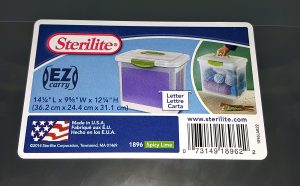 So, what to put the antenna in? Something needs to suspend and protect the antenna as a substitute for the PVC frame previously used. This Sterilite tote box is the perfect size to hold the antenna. As shown in the photo, the dimensions are approximately 14-1/4″ X 9-5/8″ X 12-1/4″; the model number is 1896.
So, what to put the antenna in? Something needs to suspend and protect the antenna as a substitute for the PVC frame previously used. This Sterilite tote box is the perfect size to hold the antenna. As shown in the photo, the dimensions are approximately 14-1/4″ X 9-5/8″ X 12-1/4″; the model number is 1896.
Early on, I decided that the flimsy “locking tabs” on the cover would not suffice for holding the relatively heavy antenna when carrying the tote by the handle. I drilled holes and attached a dozen small Nylon nuts and bolts to secure the cover. (Nylon avoids distorting the medium wave reception pattern of signals, as metal hardware could.)
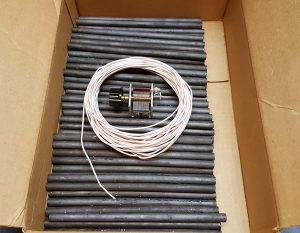 An ample quantity of 200mm ferrite rods are needed, plus a air variable capacitor (preferably with a 8:1 reduction drive shaft), and Litz wire. 1162 strands/46 ga. Litz provides the most sensitivity but the coil will cover a greater width on the rods.
An ample quantity of 200mm ferrite rods are needed, plus a air variable capacitor (preferably with a 8:1 reduction drive shaft), and Litz wire. 1162 strands/46 ga. Litz provides the most sensitivity but the coil will cover a greater width on the rods.
Gary likes to use waterproof medical tape, sticky side out, to hold the 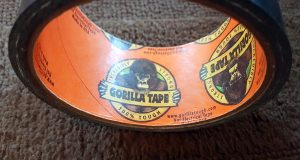 rods in place, but I like to use Gorilla brand tape, as it is extremely sticky and holds the rods better. My choice for the rod-to-coil spacing material is two turns of 1/8″ thick bubble wrap.
rods in place, but I like to use Gorilla brand tape, as it is extremely sticky and holds the rods better. My choice for the rod-to-coil spacing material is two turns of 1/8″ thick bubble wrap.
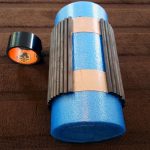 This is the foam core, ferrite rods, bubble spacer, and coil assembly
This is the foam core, ferrite rods, bubble spacer, and coil assembly 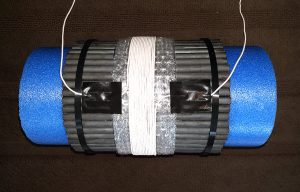 prior to fitting in the Sterilite tote container. Before assembly to this point you’ll need to cut the foam roller to length using a serrated knife or electric carving knife. Two sturdy cable ties help hold all of the rods in place. A better alternative might be strips of 1/2″ wide Velcro straps purchased from a fabric shop or home improvement store.
prior to fitting in the Sterilite tote container. Before assembly to this point you’ll need to cut the foam roller to length using a serrated knife or electric carving knife. Two sturdy cable ties help hold all of the rods in place. A better alternative might be strips of 1/2″ wide Velcro straps purchased from a fabric shop or home improvement store.
Another key item to this construction method is the use of plastic drywall anchor screws. These are meant to be 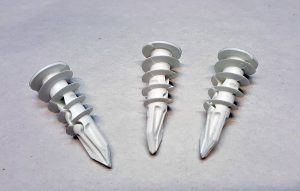 pushed and screwed into gypsum wallboard for sturdy attachment of bolts or picture hangers on walls. When screwed through drilled holes in the side of the Sterilite tote, they secure and suspend the foam roller/ferrite sleeve loop assembly. The density of the foam roller is sufficient to give a good grip to the drywall anchors. Eight to ten anchors per side are enough to hold the assembly in place. See the photo at the beginning of this article for a good view of this mounting method.
pushed and screwed into gypsum wallboard for sturdy attachment of bolts or picture hangers on walls. When screwed through drilled holes in the side of the Sterilite tote, they secure and suspend the foam roller/ferrite sleeve loop assembly. The density of the foam roller is sufficient to give a good grip to the drywall anchors. Eight to ten anchors per side are enough to hold the assembly in place. See the photo at the beginning of this article for a good view of this mounting method.
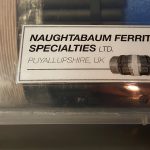 Every good FSL antenna design needs an official sounding manufacturer! With tongue firmly in cheek I’ve appropriated the name shown on this self-produced label. Clearly, a Ferrite Sleeve Loop antenna from Naughtabaum Ferrite Specialties Ltd. stands a better chance than most of passing through TSA checkpoints, right?
Every good FSL antenna design needs an official sounding manufacturer! With tongue firmly in cheek I’ve appropriated the name shown on this self-produced label. Clearly, a Ferrite Sleeve Loop antenna from Naughtabaum Ferrite Specialties Ltd. stands a better chance than most of passing through TSA checkpoints, right?
I hope this article has given you some new ideas for FSL antenna designs. There’s certainly room for improvement, including making the antenna’s ferrite rods look less intimidating…less like a bundle of dynamite! Perhaps the entire assembly can be wrapped with something that shields the rods from view, or you could use an opaque tote container rather than a clear model.
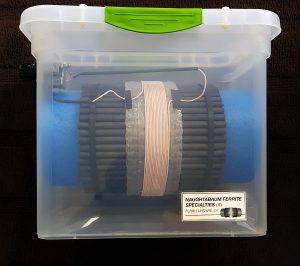 Be on the lookout for useful materials to repurpose. Trips to your local home improvement stores, office supply, and other outlets will give you further ideas on how to design your own Ferrite Sleeve Loop antenna.
Be on the lookout for useful materials to repurpose. Trips to your local home improvement stores, office supply, and other outlets will give you further ideas on how to design your own Ferrite Sleeve Loop antenna.
Guy Atkins is a Sr. Graphic Designer for T-Mobile and lives near Seattle, Washington. He’s a regular contributor to the SWLing Post.

I must send you a postcard from Puyallupshire the next I visit there.
“…… begin to sag and lose their perfectly circular shape.”
High Q cylindrical litz coils are sometimes wound on ABS pipe or joiners* by crystal radio enthusiasts. PVC is avoided.
* Size might only go to 6″.
Hi, first, good job!
I am trying to figure out how to build one for mobile use which need to be omnidirectional, I have read somewhere that placing a loop horizontally will degrade it’s performance, I wonder if FSL antenna will perform this way?
Thanks.
That’s an interesting question, Ming.
I don’t have a FSL antenna handy right now, but I did just take my CCradio-2E and tune it to a signal on 610 kHz that I often use for testing. It’s sunset right now, and the 5 Kw KONA Richland, WA station is actually very strong, with 10 bars on the 2E’s signal meter. However, when I turn the radio on end (so the ferrite loop antenna is vertical) reception drops to zero! It wasn’t audible at all in that orientation. Held at a diagonal, the station came in with various degrees of reception depending on the angle.
I suspect that a FSL antenna will perform similarly.
Guy Atkins
Puyallup, WA
Hi, thanks for the experiment!
how about if I place two FSL crossed, with short ferrites, like those crossed loop antennas? will the ferrite obstruct magnetic field enough to become a problem?
Merry Christmas.
Ming.
Hmm, thinking again the ferrite bar in front of another FSL might not be a problem if those bars “appears” transparent to magnetic fields, only left the wire in front which might not be a problem as other crossed loop antenna has been in use for some time… just a thought…
Hi Ming,
To my understanding, only single wire (or rod) loop antennas of the magnetic type can potentially be arranged in a crossed horizontal-vertical orientation. A ferrite loop, or FSL is different and its reception pattern can be severely warped by another antenna within its field. Some DXers have used this effect in a positive way to phase or redirect the null of FSLs when placed close to each other. I believe there is an article by Kevin Schanilec on the DXer.ca web site about this. However, I do not think you can get omnidirectional FSL reception when the antennas are arranged as you describe–it would take magnetic cross-field loops for this.
This is the design I am thinking of: https://swling.com/blog/category/tutorials/page/3/
73, Guy
Now that I’ve read this, I think most if not all of the antennas I made suck due to the fact that they’re all lacking fun noodles. I think this will be the next big thing in antenna design! 🙂
Ha ha ha! These guys know how to make antennas fun to their core!
Ferrite bars are made from an alloy of silica and unobtaium
Those 200 mm ferrite rods are getting kind of expensive these days, it seems.
They certainly are, Mike. The prices fluctuate regularly. As Gary DeBock has pointed out, the Ukrainian and Latvian sellers of the ferrite mods must monitor the level of hobby interest in Ultralight radios and FSL antennas and adjust their prices accordingly. However, serious fun and performance can still be found with the smaller 3 to 5 inch diameter FSLs. Gary’s activities of late clearly illustrate how you can build excellent small ferrite sleeve loops for under $100 USD, at today’s ferrite rod prices. These compact designs use shorter, typically 140mm long rods. As an example, see: https://swling.com/blog/2016/12/video-gary-debocks-baby-fsl-antenna/
Last summer, another radio enthusiast and I spent some hours in a rural, low noise setting, comparing the 7-inch FSL in the article above to my larger 12-inch diameter FSL antenna. After lots of testing with a half dozen different portable radios, we concluded that the 7-inch model has roughly 90% of the performance of the 12-inch FSL–on *domestic* MW signals. I have no doubt the larger antenna would outperform the smaller one at the coast with the weakest trans-Pacific MW stations however. Gary’s DXing success with the New Zealand and Australian stations during his Oregon coast trips has shown this over and over, too.
Bottom line observation: smaller FSL antennas are better for the typical MW DXer with their lower price, simpler construction, easier portability, and the greatest bang for the buck.
Hats off to Gary and Guy for being innovators in this aspect of the DXing hobby!
This is inspiring and well within the spirit of ultralight DXing. That is, catching serious DX with modestly priced gear. A little “sweat equity” and ingenuity paired with an inexpensive Ultralight receiver can yield impressive results. Represents all that is good about our radio hobby!
Guy I hope you let us know how your Naughtabaum (hi hi) performs on one of your joint dxpeditions.
Most impressive, Guy!!!
You bring up such a good point, too. When we’re hanging out with other DXers…say, on the side of a cliff facing the Pacific, it doesn’t really matter what our antennas and accessories look like. We’re there with our buddies playing radio and catching DX–form follows function.
No doubt, though, you will be hassled at the airport if you try to take one on an airplane. Those ferrite bars wrapped around a dielectric center would appear quite odd under an x-ray machine. Without a doubt, it would be the first of its kind for any TSA employee. You will likely be searched and your baggage searched even if checked in.
I remember I purchased an early release of the Yaesu FT-817 when I lived in the UK. I bought it to take along my very frequent travels throughout Europe. Shortly after I bought it, 9/11 happened. I started carrying my printed ham radio license and the FT-817 owner’s manual in my carry-on with the ‘817, but I would typically be questioned about the FT-817 (which obviously looked like a commercially-produced radio). I was never hassled too badly, but it was bothersome enough that I wouldn’t carry the ‘817 if I was on a tight schedule.
But back to your FSL antenna design: what I really like about it, Guy, is it’s protected from the elements! I imagine those ferrite bars like being dry–living in the Pacific NW, I’m sure you’ve had unexpected rain while DXing! I would probably put a few of those Silica Desiccant packs in the box while being stored.
Oh, and “Naughtabaum Ferrite Specialties Ltd.”–? Love it!!!
Brilliant design–thanks for sharing, Guy!
It’s very interesting, Thomas, that your FT-817 would be questioned at all. Perhaps it looked too high tech and unusual when the radio was introduced. It’s for explanation reasons like this why I got my ham ticket 10 years ago; it’s helped me to take radio equipment to Canada and back for DXpeditions. It certainly cuts down on the “splaining” I have to do :^)
Rain while DXing on the Pacific NW coast is a given, and sometimes it’s near-horizontal rain too! Gary is the only DXer I know who’s serious–or crazy?–enough to stand outside and DX in that weather. He catches some amazing Kiwi and Aussie DX via the FSLs for his efforts though. I’m content to DX the lazy man’s way, with a SDR rig from inside a vehicle. I save the FSL fun for more tame conditions.
I hadn’t thought about the FSL antenna going though the X-ray machine, Thomas. Even if I made one of these antennas look totally innocuous from the outside, it’s certainly going to raise eyebrows when the ferrite rods are visible through X-ray.
“… your FT-817 would be questioned at all.” DHS looks for more than potential terrorism suspects, maybe antique smugglers on their watch list? I wonder what they would think of my heath GR 78?